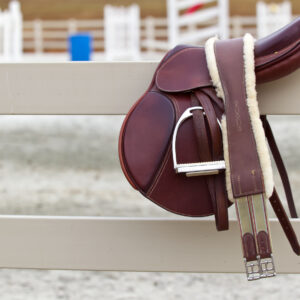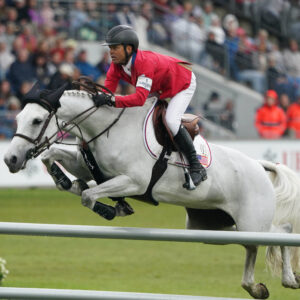I flash back on occasion to the early years of my horse-trailering experience—begging rides from acquaintances, loading my 4-H project pony into whatever rig might be passing by our driveway on its way to the fair, riding in the back of a pickup truck, holding fast to lead ropes attached to two, wide-eyed Miniature Horses, their wild manes blown back by the vehicle’s—probably reckless, given its passengers—speed.
I was a kid, my parents weren’t horsey, and none of us knew any better…until we did. And thank goodness we did eventually learn about safe and responsible horse transport. As veterinarian Dr. Madison Seamans points out in one of the many mind-expanding stories he shares in his new memoir Never Trust a Sneaky Pony, it is pretty much a miracle any horse lets us load him into any one of these contraptions—never mind what can actually happen when we head on down the road.
***
Transporting horses is the source of some fear and anxiety among us, and I find it very interesting how many horses who may otherwise be pretty solid citizens become absolute maniacs when we ask ‘em to get in a trailer.
But I also think anyone that drags one of these scary rolling boxes down the road at sixty miles an hour ought to be required by law to ride in one first. They are loud, dusty, and hard to stand up in, even for me, so I can only imagine what horses must think during their first experiences in these contraptions. Thankfully, most horses are pretty forgiving, or we’d never be able to load ‘em the second time so we could take ‘em back where we started.
Dr. Bo Brock, a renowned veterinarian in Lamesa, Texas, told me a story years ago about a client who didn’t want to pay for a farm call. Dr. Brock told him: “You could just bring your horse in to the clinic. That will save me some time and you some money.”
“Well, I don’t exactly have a horse trailer,” the client said, “but I’ll see what I can do.”
There was no small stir in the parking lot of Dr. Brock’s clinic when the client arrived with the horse standing patiently on a flatbed trailer—a flatbed trailer, as in one with no sides! I think of this episode occasionally when I hear someone stressing about hauling a horse: There are questions about how to feed and water a horse for a trailer ride. Should there be bedding? Straw or shavings? Air-conditioning? Video monitor? Meanwhile, this horse in Texas apparently tolerated a ten-mile ride into town—and back—on a completely open flatbed trailer. This is a great illustration of just how basic we can get and how accommodating some horses can be if we just give ‘em a chance. Maybe we overthink this whole trailering thing.
Up until about thirty years ago, every trailer was a “straight load,” meaning the horses stood front to back. I noticed years ago that many cowboy horses were hauled standing loose in large stock trailers that doubled as cow trailers. (I guess ranchers in those days didn’t get too worried about their prize show horses stepping in slimy poop left by careless cows—apparently those days are gone.) Anyway, horses in stock trailers seemed to prefer to stand facing the rear and diagonally. Then, back in the late seventies, some very smart, observant person recognized the horse figured out the easiest way to survive a ride in one of these rolling nightmares and changed the design to accept the horse’s opinion on the matter. I’m guessing this was the origin of the “slant-load” trailer.
Fancy slant-loads with living quarters are all the rage now—some of ‘em cost more than my house! But the standard, very useful four-horse stock trailer can still be found in the barnyard of just about every ranch in the western United States. These are usually built to last and can serve a variety of functions. One feature on most of these is a slider inside the back door. This allows the rancher to unload a calf (theoretically) without unloading the cow (real theoretically…this works a lot better on paper than on the ranch).
One of these things backfired on us a few years ago. I was attending to Cinnamon, a good mare with a bad colic. None of my go-to remedies were having any effect, and her colon was suspiciously displaced. I determined this with my favorite long plastic sleeve, some lube, and no small amount of nerve.
Upon removing my arm, I explained our dilemma to the client, Cathy. “I’m a little concerned we may be dealing with a displacement, or even a twist in her large bowel,” I said, “and this may need another set of eyes and hands to figure out what to do. We may even need surgery to save her.”
I really hate this type of case, as many of these surgical patients die on the table or have serious complications during the six-month convalescent period. Some do very well after surgery, but, in reality, there’s only three things that can happen, and two of ‘em are bad.
Cathy and I discussed the options, possible outcome of surgical intervention—and, oh yeah…the price. She and her husband Carl stepped away a few feet, but not so far that I couldn’t hear some “frank negotiations”—meaning a discussion just short of flying fists.
“We are going to surgery!” Cathy announced.
I knew the surgeon would be short-handed that day, so I drove to his clinic just in case he needed help. Carl and Cathy arrived a few minutes later in their trusty Ford pickup and four-horse stock trailer. Cathy was out the door quickly to get Cinnamon out of the trailer to start her treatment.
From the back of the trailer, we heard a shout: “She’s gone!”
Carl, the surgeon, and I stood silently for a few beats, respectfully waiting to share in the sorrow of the moment.
Carl spoke first: “I’m sorry, sweetheart. We knew she was pretty sick.”
“No!” Cathy replied again. “NO! She’s GONE!”
“I know.” Carl was reaching deep into his empathy pocket. “Maybe this was for the best. She isn’t suffering anymore.”
“NO!” she fumed. “You stupid @#$%&*!…She’s not in the trailer!”
Sure enough, the trailer was empty—the slider in the back gate had somehow opened during the trip. Apparently, Carl had missed the road to the clinic, and during his effort to turn around, the gate slid open…and the mare slid out.
They found Cinnamon grazing in the ditch beside the road as if this happened all the time. The trailer ride apparently allowed her colon to reposition itself and surgery was not required. She spent the night at the clinic, just to be safe, and rode home the next day with the slider secured with the ubiquitous orange bailing twine…just to be safe.

This excerpt from Never Trust a Sneaky Pony by Dr. Madison Seamans is reprinted with permission from Trafalgar Square Books (www.HorseandRiderBooks.com).


 February 6, 2023
February 6, 2023 

























